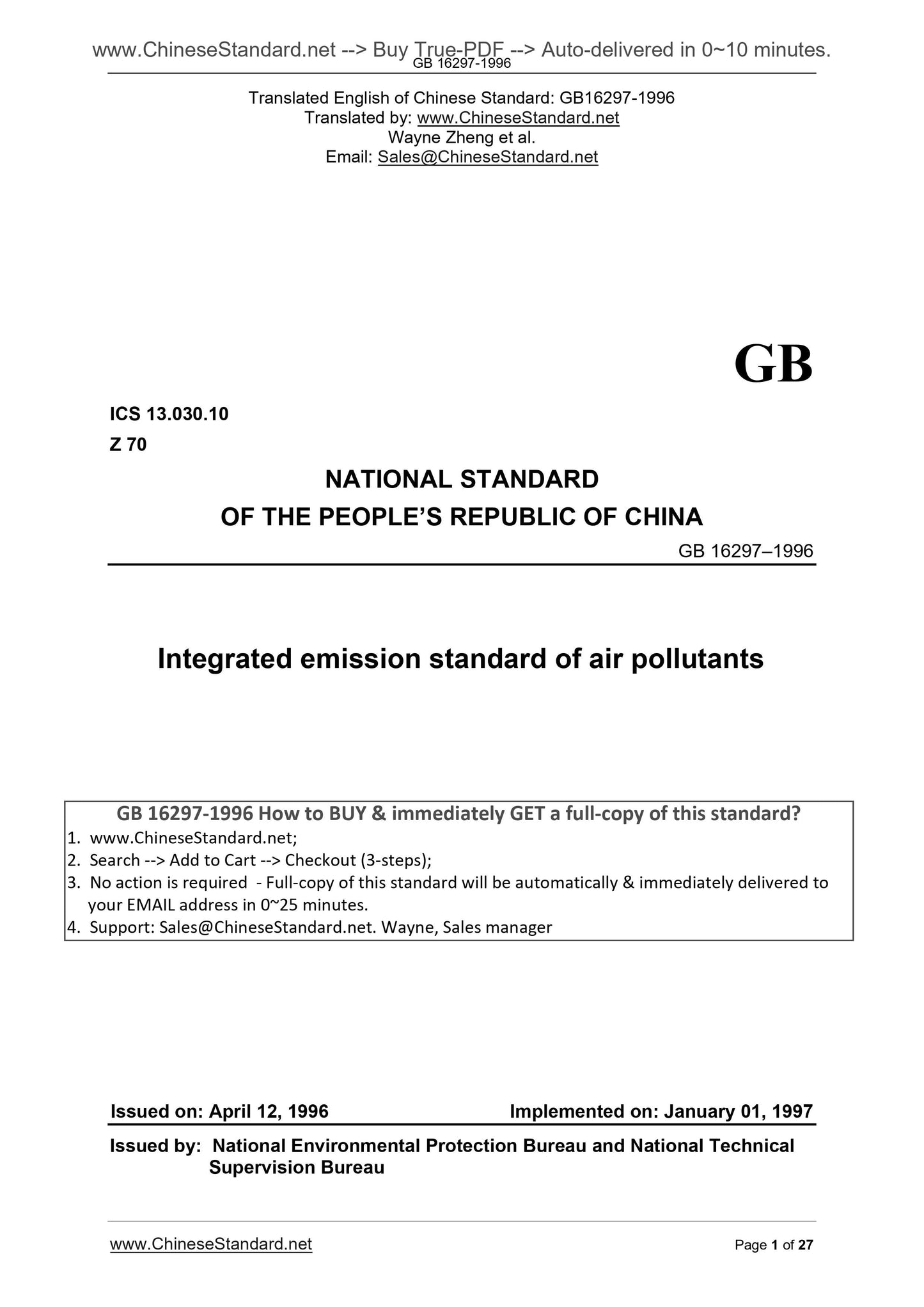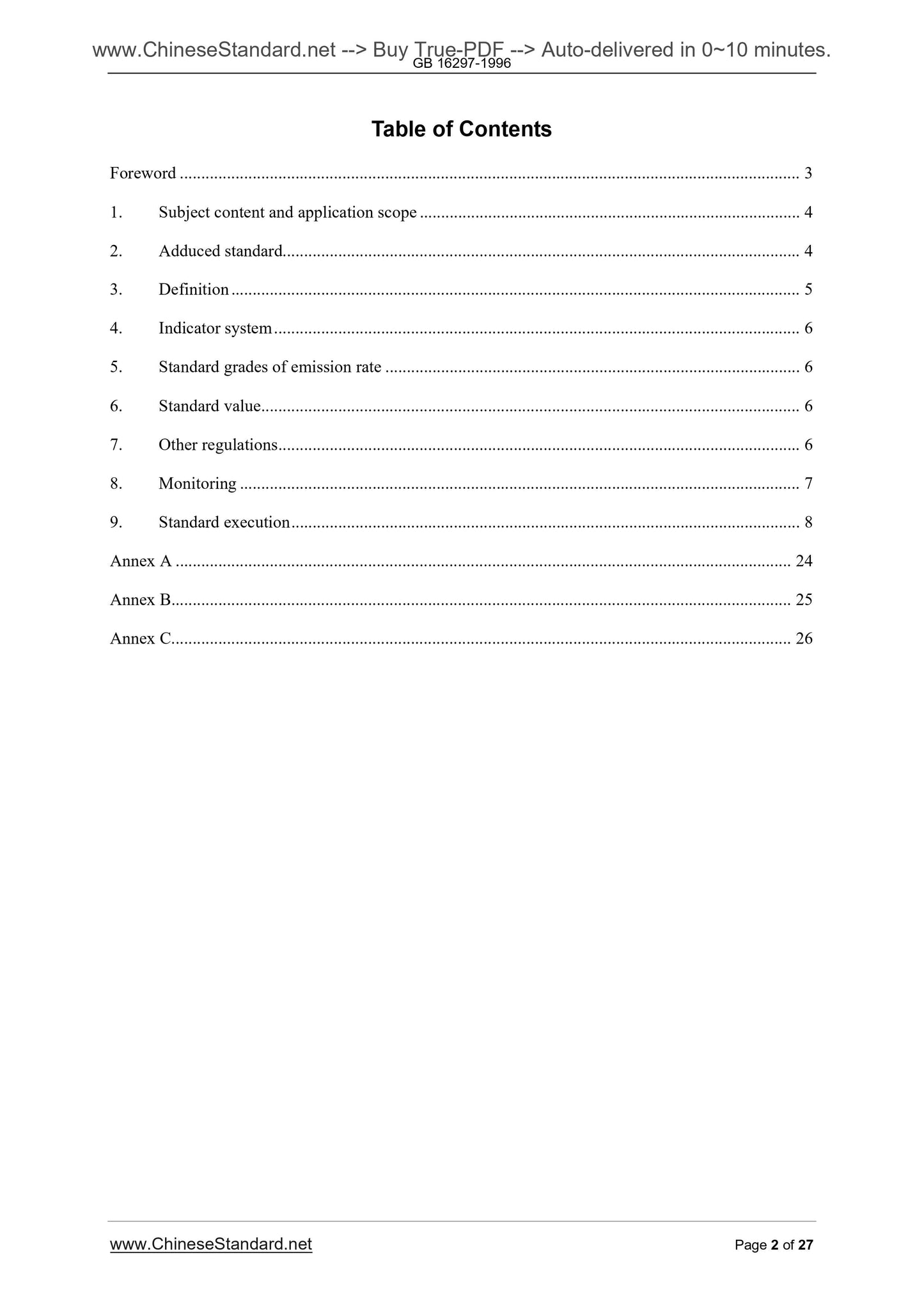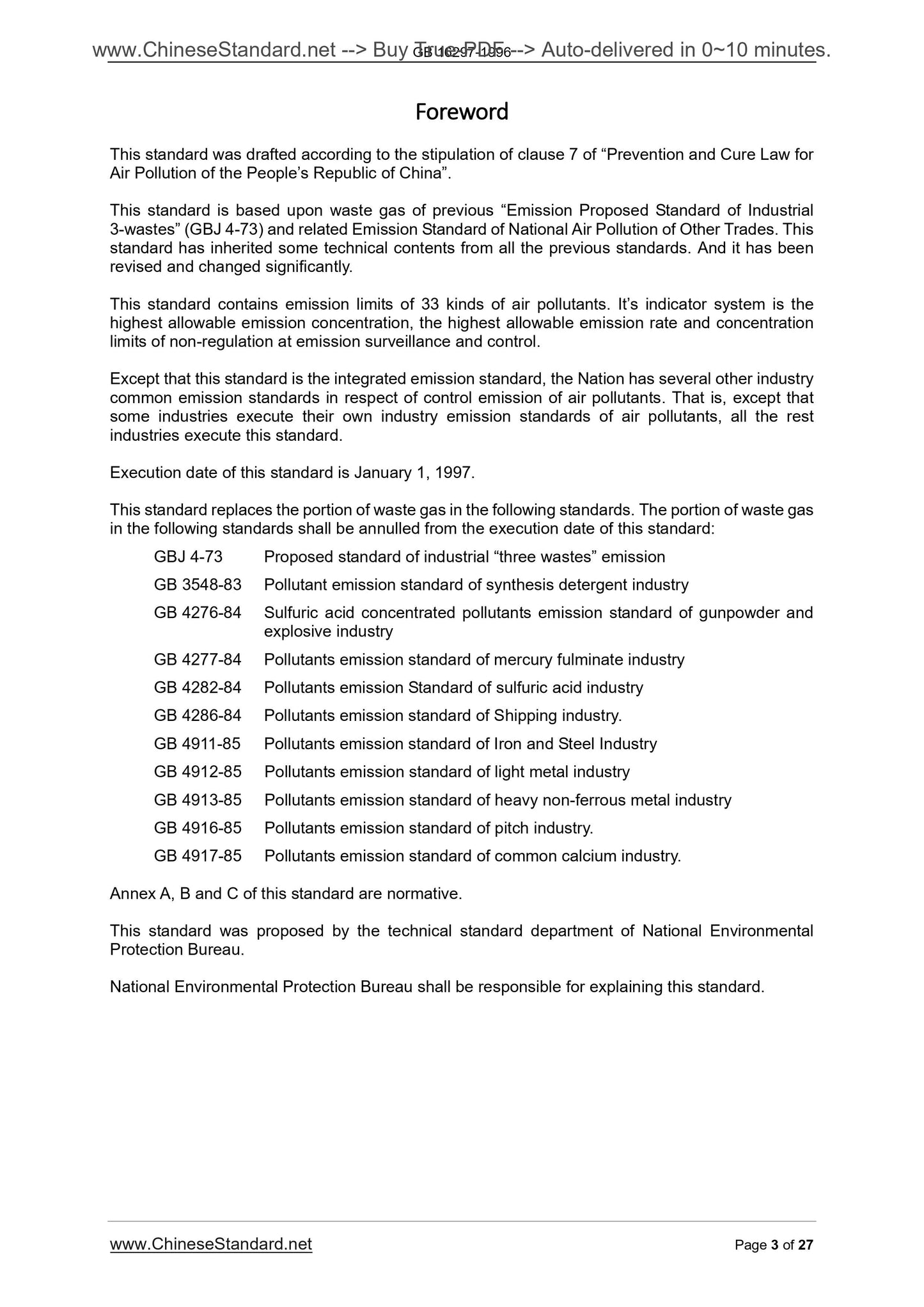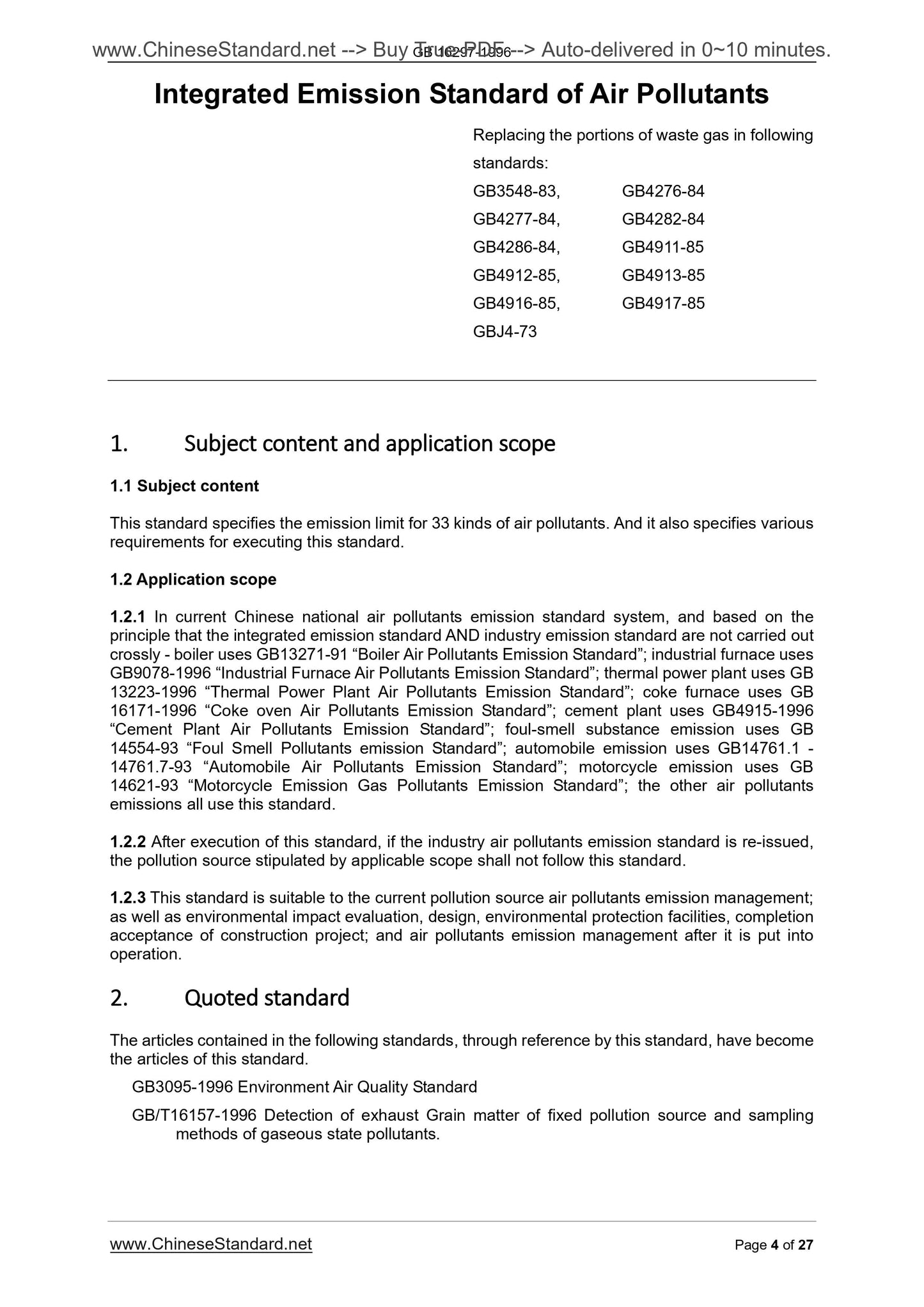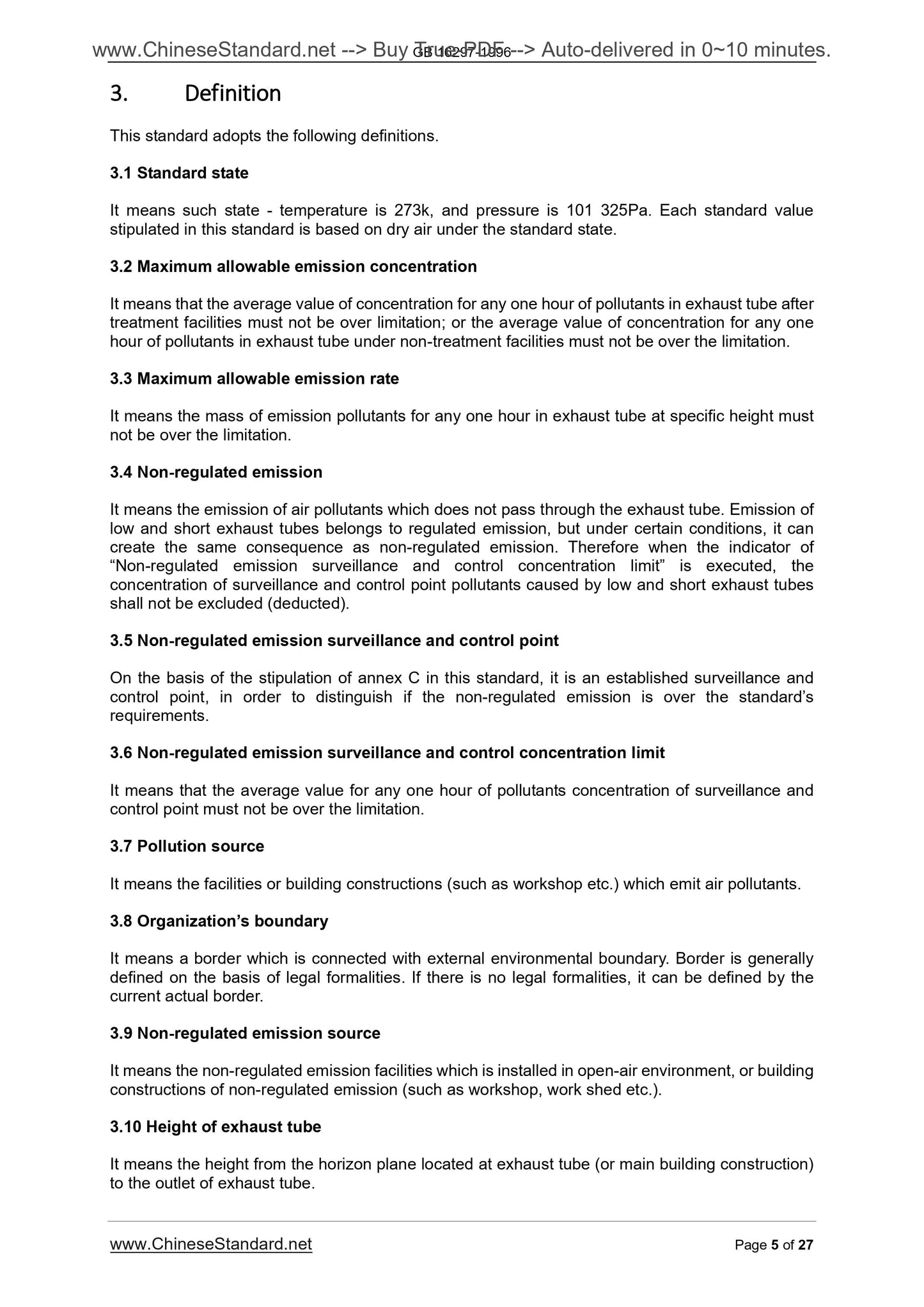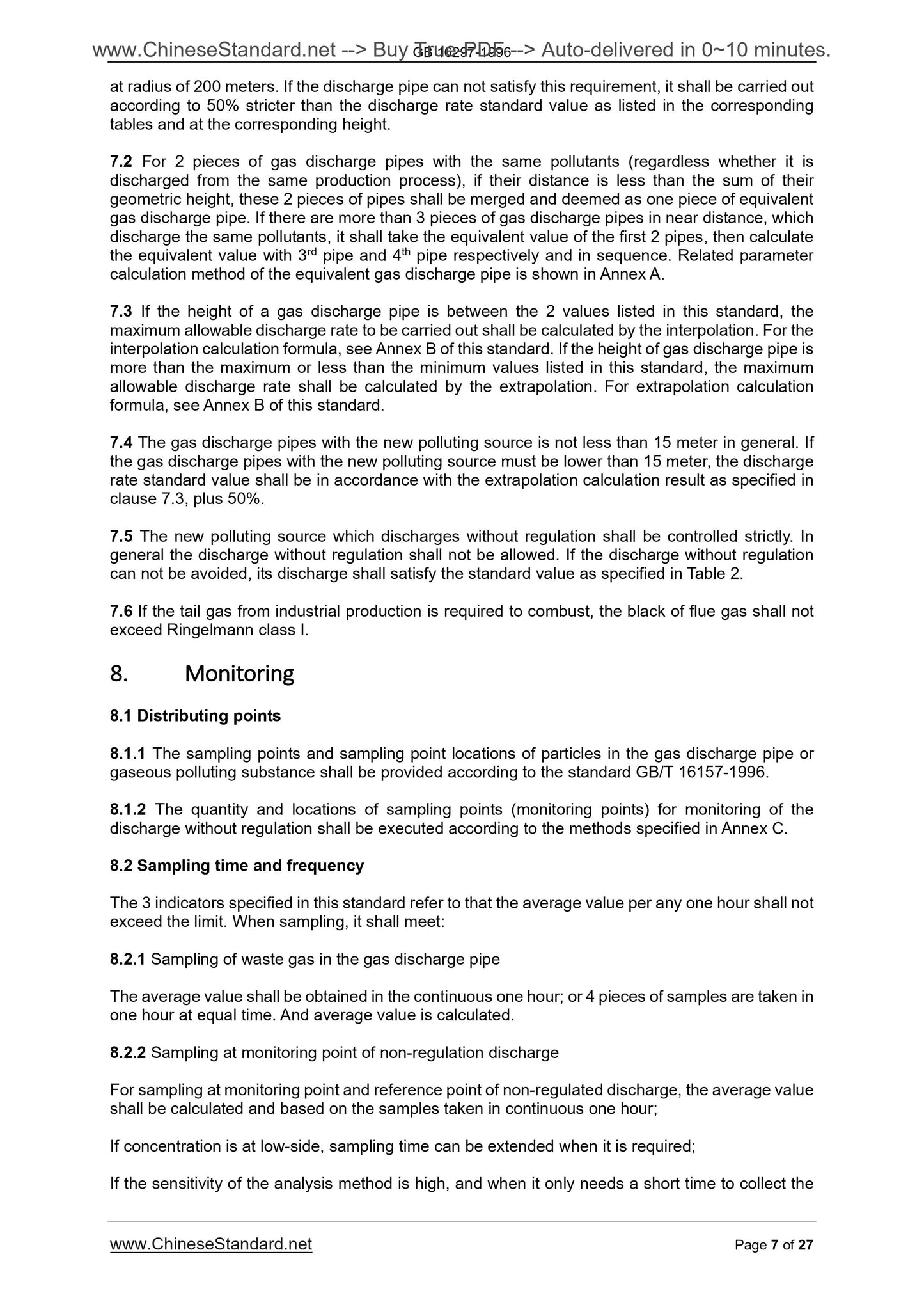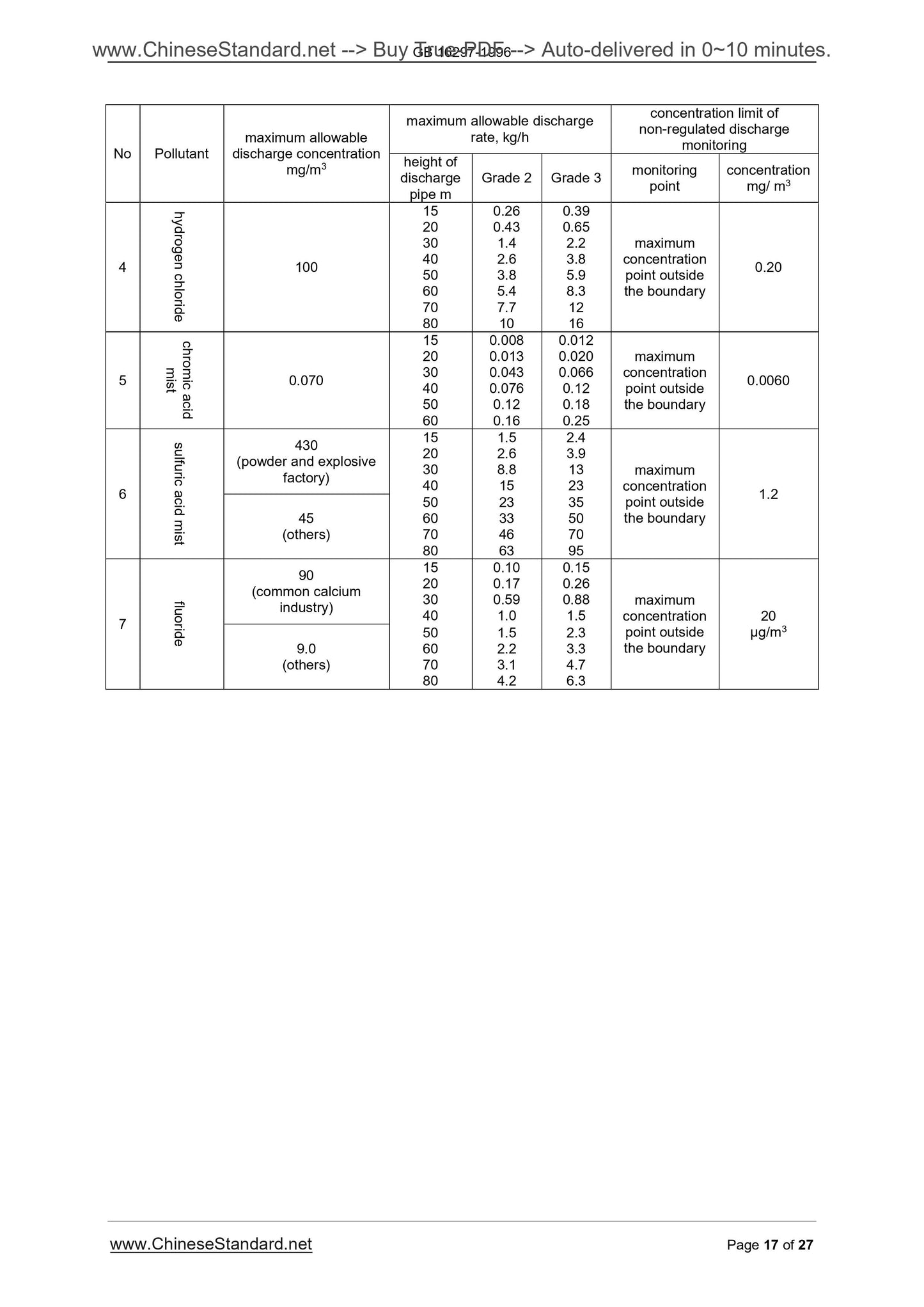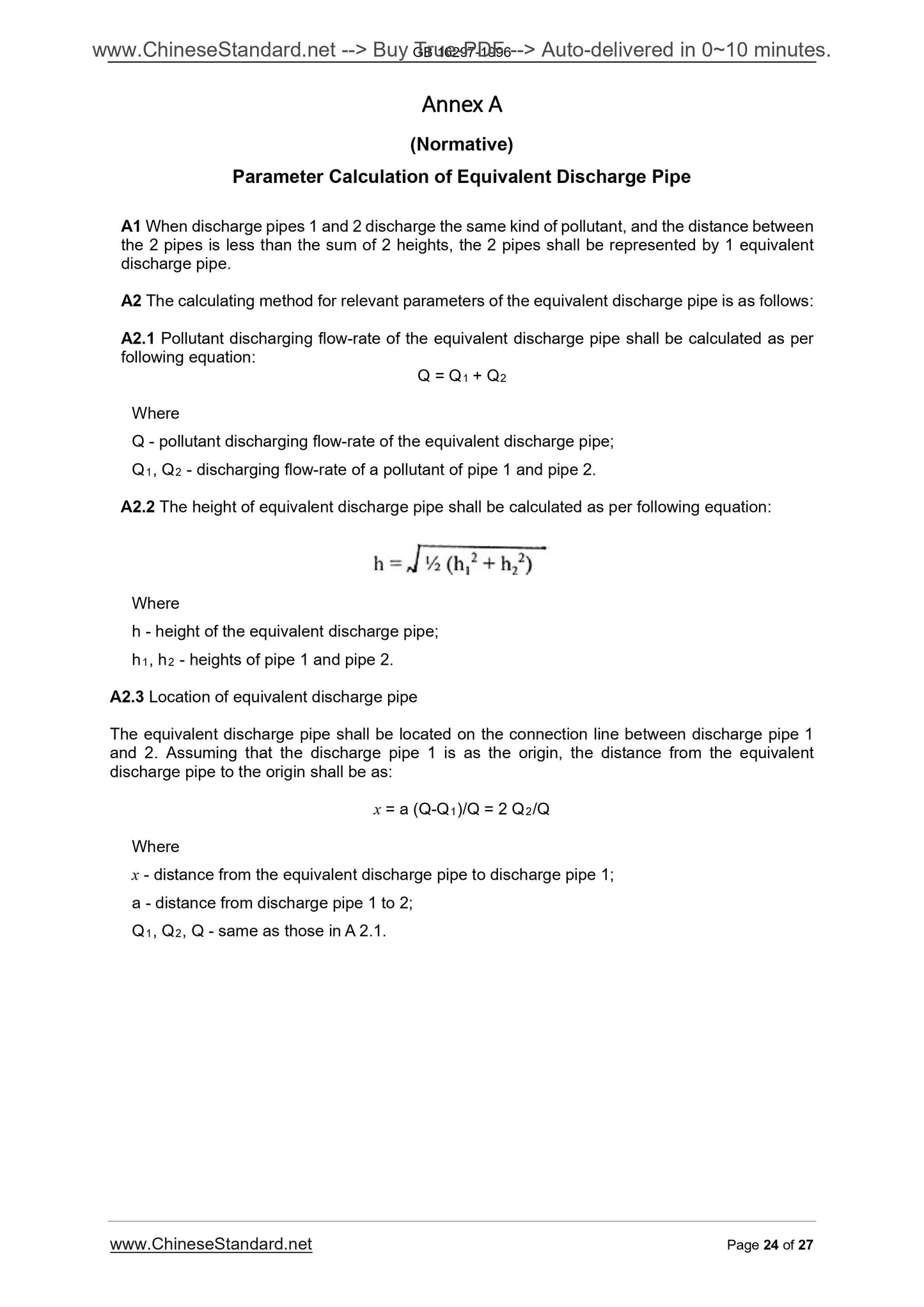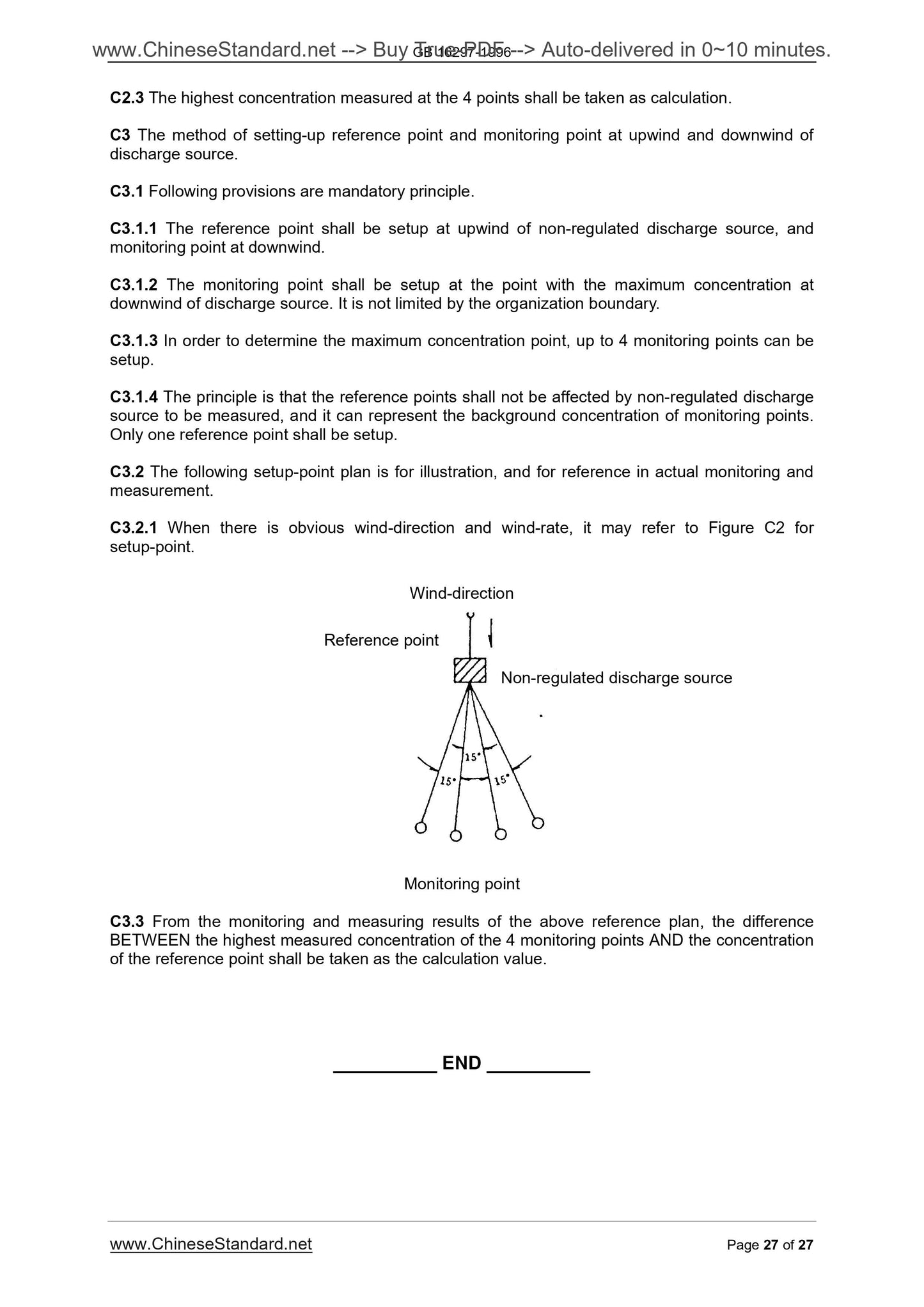1
/
of
9
PayPal, credit cards. Download editable-PDF & invoice in 1 second!
GB 16297-1996 English PDF (GB16297-1996)
GB 16297-1996 English PDF (GB16297-1996)
Regular price
$145.00 USD
Regular price
Sale price
$145.00 USD
Unit price
/
per
Shipping calculated at checkout.
Couldn't load pickup availability
Delivery: 3 seconds. Download true-PDF + Invoice.
Get QUOTATION in 1-minute: Click GB 16297-1996
Historical versions: GB 16297-1996
Preview True-PDF (Reload/Scroll if blank)
GB 16297-1996: Integrated emission standard of air pollutants
GB 16297-1996
GB
ICS 13.030.10
Z 70
NATIONAL STANDARD
OF THE PEOPLE’S REPUBLIC OF CHINA
GB 16297–1996
Integrated emission standard of air pollutants
ISSUED ON. APRIL 12, 1996
IMPLEMENTED ON. JANUARY 01, 1997
Issued by. National Environmental Protection Bureau and National Technical
Supervision Bureau
Table of Contents
Foreword ... 3
1. Subject content and application scope ... 4
2. Adduced standard... 4
3. Definition ... 5
4. Indicator system ... 6
5. Standard grades of emission rate ... 6
6. Standard value ... 6
7. Other regulations ... 6
8. Monitoring ... 7
9. Standard execution ... 8
Annex A ... 24
Annex B ... 25
Annex C ... 26
Foreword
This standard was drafted according to the stipulation of clause 7 of “Prevention and Cure Law for
Air Pollution of the People’s Republic of China”.
This standard is based upon waste gas of previous “Emission Proposed Standard of Industrial
3-wastes” (GBJ 4-73) and related Emission Standard of National Air Pollution of Other Trades. This
standard has inherited some technical contents from all the previous standards. And it has been
revised and changed significantly.
This standard contains emission limits of 33 kinds of air pollutants. It’s indicator system is the
highest allowable emission concentration, the highest allowable emission rate and concentration
limits of non-regulation at emission surveillance and control.
Except that this standard is the integrated emission standard, the Nation has several other industry
common emission standards in respect of control emission of air pollutants. That is, except that
some industries execute their own industry emission standards of air pollutants, all the rest
industries execute this standard.
Execution date of this standard is January 1, 1997.
This standard replaces the portion of waste gas in the following standards. The portion of waste gas
in the following standards shall be annulled from the execution date of this standard.
GBJ 4-73 Proposed standard of industrial “three wastes” emission
GB 3548-83 Pollutant emission standard of synthesis detergent industry
GB 4276-84 Sulfuric acid concentrated pollutants emission standard of gunpowder and
explosive industry
GB 4277-84 Pollutants emission standard of mercury fulminate industry
GB 4282-84 Pollutants emission Standard of sulfuric acid industry
GB 4286-84 Pollutants emission standard of Shipping industry.
GB 4911-85 Pollutants emission standard of Iron and Steel Industry
GB 4912-85 Pollutants emission standard of light metal industry
GB 4913-85 Pollutants emission standard of heavy non-ferrous metal industry
GB 4916-85 Pollutants emission standard of pitch industry.
GB 4917-85 Pollutants emission standard of common calcium industry.
Annex A, B and C of this standard are normative.
This standard was proposed by the technical standard department of National Environmental
Protection Bureau.
National Environmental Protection Bureau shall be responsible for explaining this standard.
Integrated Emission Standard of Air Pollutants
Replacing the portions of waste gas in following
standards.
GB3548-83, GB4276-84
GB4277-84, GB4282-84
GB4286-84, GB4911-85
GB4912-85, GB4913-85
GB4916-85, GB4917-85
GBJ4-73
1. Subject content and application scope
1.1 Subject content
This standard specifies the emission limit for 33 kinds of air pollutants. And it also specifies various
requirements for executing this standard.
1.2 Application scope
1.2.1 In current Chinese national air pollutants emission standard system, and based on the
principle that the integrated emission standard AND industry emission standard are not carried out
crossly - boiler uses GB13271-91 “Boiler Air Pollutants Emission Standard”; industrial furnace uses
GB9078-1996 “Industrial Furnace Air Pollutants Emission Standard”; thermal power plant uses GB
13223-1996 “Thermal Power Plant Air Pollutants Emission Standard”; coke furnace uses GB
16171-1996 “Coke oven Air Pollutants Emission Standard”; cement plant uses GB4915-1996
“Cement Plant Air Pollutants Emission Standard”; foul-smell substance emission uses GB
14554-93 “Foul Smell Pollutants emission Standard”; automobile emission uses GB14761.1 -
14761.7-93 “Automobile Air Pollutants Emission Standard”; motorcycle emission uses GB
14621-93 “Motorcycle Emission Gas Pollutants Emission Standard”; the other air pollutants
emissions all use this standard.
1.2.2 After execution of this standard, if the industry air pollutants emission standard is re-issued,
the pollution source stipulated by applicable scope shall not follow this standard.
1.2.3 This standard is suitable to the current pollution source air pollutants emission management;
as well as environmental impact evaluation, design, environmental protection facilities, completion
acceptance of construction project; and air pollutants emission management after it is put into
operation.
2. Quoted standard
The articles contained in the following standards, through reference by this standard, have become
the articles of this standard.
GB3095-1996 Environment Air Quality Standard
GB/T16157-1996 Detection of exhaust Grain matter of fixed pollution source and sampling
methods of gaseous state pollutants.
3. Definition
This standard adopts the following definitions.
3.1 Standard state
It means such state - temperature is 273k, and pressure is 101 325Pa. Each standard value
stipulated in this standard is based on dry air under the standard state.
3.2 Maximum allowable emission concentration
It means that the average value of concentration for any one hour of pollutants in exhaust tube after
treatment facilities must not be over limitation; or the average value of concentration for any one
hour of pollutants in exhaust tube under non-treatment facilities must not be over the limitation.
3.3 Maximum allowable emission rate
It means the mass of emission pollutants for any one hour in exhaust tube at specific height must
not be over the limitation.
3.4 Non-regulated emission
It means the emission of air pollutants which does not pass through the exhaust tube. Emission of
low and short exhaust tubes belongs to regulated emission, but under certain conditions, it can
create the same consequence as non-regulated emission. Therefore when the indicator of
“Non-regulated emission surveillance and control concentration limit” is executed, the
concentration of surveillance and control point pollutants caused by low and short exhaust tubes
shall not be excluded (deducted).
3.5 Non-regulated emission surveillance and control point
On the basis of the stipulation of annex C in this standard, it is an established surveillance and
control point, in order to distinguish if the non-regulated emission is over the standard’s
requirements.
3.6 Non-regulated emission surveillance and control concentration limit
It means that the average value for any one hour of pollutants concentration of surveillance and
control point must not be over the limitation.
3.7 Pollution source
It means the facilities or building constructions (such as workshop etc.) which emit air pollutants.
3.8 Organization’s boundary
It means a border which is connected with external environmental boundary. Border is generally
defined on the basis of legal formalities. If there is no legal formalities, it can be defined by the
current actual border.
3.9 Non-regulated emission source
It means the non-reg...
Get QUOTATION in 1-minute: Click GB 16297-1996
Historical versions: GB 16297-1996
Preview True-PDF (Reload/Scroll if blank)
GB 16297-1996: Integrated emission standard of air pollutants
GB 16297-1996
GB
ICS 13.030.10
Z 70
NATIONAL STANDARD
OF THE PEOPLE’S REPUBLIC OF CHINA
GB 16297–1996
Integrated emission standard of air pollutants
ISSUED ON. APRIL 12, 1996
IMPLEMENTED ON. JANUARY 01, 1997
Issued by. National Environmental Protection Bureau and National Technical
Supervision Bureau
Table of Contents
Foreword ... 3
1. Subject content and application scope ... 4
2. Adduced standard... 4
3. Definition ... 5
4. Indicator system ... 6
5. Standard grades of emission rate ... 6
6. Standard value ... 6
7. Other regulations ... 6
8. Monitoring ... 7
9. Standard execution ... 8
Annex A ... 24
Annex B ... 25
Annex C ... 26
Foreword
This standard was drafted according to the stipulation of clause 7 of “Prevention and Cure Law for
Air Pollution of the People’s Republic of China”.
This standard is based upon waste gas of previous “Emission Proposed Standard of Industrial
3-wastes” (GBJ 4-73) and related Emission Standard of National Air Pollution of Other Trades. This
standard has inherited some technical contents from all the previous standards. And it has been
revised and changed significantly.
This standard contains emission limits of 33 kinds of air pollutants. It’s indicator system is the
highest allowable emission concentration, the highest allowable emission rate and concentration
limits of non-regulation at emission surveillance and control.
Except that this standard is the integrated emission standard, the Nation has several other industry
common emission standards in respect of control emission of air pollutants. That is, except that
some industries execute their own industry emission standards of air pollutants, all the rest
industries execute this standard.
Execution date of this standard is January 1, 1997.
This standard replaces the portion of waste gas in the following standards. The portion of waste gas
in the following standards shall be annulled from the execution date of this standard.
GBJ 4-73 Proposed standard of industrial “three wastes” emission
GB 3548-83 Pollutant emission standard of synthesis detergent industry
GB 4276-84 Sulfuric acid concentrated pollutants emission standard of gunpowder and
explosive industry
GB 4277-84 Pollutants emission standard of mercury fulminate industry
GB 4282-84 Pollutants emission Standard of sulfuric acid industry
GB 4286-84 Pollutants emission standard of Shipping industry.
GB 4911-85 Pollutants emission standard of Iron and Steel Industry
GB 4912-85 Pollutants emission standard of light metal industry
GB 4913-85 Pollutants emission standard of heavy non-ferrous metal industry
GB 4916-85 Pollutants emission standard of pitch industry.
GB 4917-85 Pollutants emission standard of common calcium industry.
Annex A, B and C of this standard are normative.
This standard was proposed by the technical standard department of National Environmental
Protection Bureau.
National Environmental Protection Bureau shall be responsible for explaining this standard.
Integrated Emission Standard of Air Pollutants
Replacing the portions of waste gas in following
standards.
GB3548-83, GB4276-84
GB4277-84, GB4282-84
GB4286-84, GB4911-85
GB4912-85, GB4913-85
GB4916-85, GB4917-85
GBJ4-73
1. Subject content and application scope
1.1 Subject content
This standard specifies the emission limit for 33 kinds of air pollutants. And it also specifies various
requirements for executing this standard.
1.2 Application scope
1.2.1 In current Chinese national air pollutants emission standard system, and based on the
principle that the integrated emission standard AND industry emission standard are not carried out
crossly - boiler uses GB13271-91 “Boiler Air Pollutants Emission Standard”; industrial furnace uses
GB9078-1996 “Industrial Furnace Air Pollutants Emission Standard”; thermal power plant uses GB
13223-1996 “Thermal Power Plant Air Pollutants Emission Standard”; coke furnace uses GB
16171-1996 “Coke oven Air Pollutants Emission Standard”; cement plant uses GB4915-1996
“Cement Plant Air Pollutants Emission Standard”; foul-smell substance emission uses GB
14554-93 “Foul Smell Pollutants emission Standard”; automobile emission uses GB14761.1 -
14761.7-93 “Automobile Air Pollutants Emission Standard”; motorcycle emission uses GB
14621-93 “Motorcycle Emission Gas Pollutants Emission Standard”; the other air pollutants
emissions all use this standard.
1.2.2 After execution of this standard, if the industry air pollutants emission standard is re-issued,
the pollution source stipulated by applicable scope shall not follow this standard.
1.2.3 This standard is suitable to the current pollution source air pollutants emission management;
as well as environmental impact evaluation, design, environmental protection facilities, completion
acceptance of construction project; and air pollutants emission management after it is put into
operation.
2. Quoted standard
The articles contained in the following standards, through reference by this standard, have become
the articles of this standard.
GB3095-1996 Environment Air Quality Standard
GB/T16157-1996 Detection of exhaust Grain matter of fixed pollution source and sampling
methods of gaseous state pollutants.
3. Definition
This standard adopts the following definitions.
3.1 Standard state
It means such state - temperature is 273k, and pressure is 101 325Pa. Each standard value
stipulated in this standard is based on dry air under the standard state.
3.2 Maximum allowable emission concentration
It means that the average value of concentration for any one hour of pollutants in exhaust tube after
treatment facilities must not be over limitation; or the average value of concentration for any one
hour of pollutants in exhaust tube under non-treatment facilities must not be over the limitation.
3.3 Maximum allowable emission rate
It means the mass of emission pollutants for any one hour in exhaust tube at specific height must
not be over the limitation.
3.4 Non-regulated emission
It means the emission of air pollutants which does not pass through the exhaust tube. Emission of
low and short exhaust tubes belongs to regulated emission, but under certain conditions, it can
create the same consequence as non-regulated emission. Therefore when the indicator of
“Non-regulated emission surveillance and control concentration limit” is executed, the
concentration of surveillance and control point pollutants caused by low and short exhaust tubes
shall not be excluded (deducted).
3.5 Non-regulated emission surveillance and control point
On the basis of the stipulation of annex C in this standard, it is an established surveillance and
control point, in order to distinguish if the non-regulated emission is over the standard’s
requirements.
3.6 Non-regulated emission surveillance and control concentration limit
It means that the average value for any one hour of pollutants concentration of surveillance and
control point must not be over the limitation.
3.7 Pollution source
It means the facilities or building constructions (such as workshop etc.) which emit air pollutants.
3.8 Organization’s boundary
It means a border which is connected with external environmental boundary. Border is generally
defined on the basis of legal formalities. If there is no legal formalities, it can be defined by the
current actual border.
3.9 Non-regulated emission source
It means the non-reg...
Share
